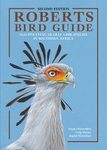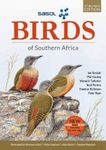World / Checklist
Out of Print
By: Paul Isenmann(Author), Jens Hering(Author), Stefan Brehme(Author), Mohamed Essghaier(Author), Khaled Etayeb(Author), Essam Bourass(Author), Hichem Azafzaf(Author)
302 pages, colour photos, colour distribution maps
![Birds of Libya / Oiseaux de Libye Birds of Libya / Oiseaux de Libye]()
Click to have a closer look
About this book
Customer reviews
Related titles
About this book
Language: Bilingual in English and French
Birds of Libya / Oiseaux de Libye is written in English and French and is an annotated checklist of the 350 bird species (of which 100 are currently breeding) recorded in Libya. This North African country is mostly a Saharan country and its avifauna belongs to the Palearctic. It gives information on the geography and climate, a comprehensive list of all the recorded bird species of wild origin, a biogeographical analysis of the breeding species and the place of Libya in the Mediterranean and Palearctic–Afrotropical migration systems. The annotated checklist provides data on the species' status, phenology, distribution, habitat, nesting and the origin of migrants and winter visitors. A list of references and a gazetteer close the book. Birds of Libya / Oiseaux de Libye is the result of cooperation between ornithologists from Libya, France, Germany and Tunisia.
Summary in French:
Ce livre bilingue Anglais-Français est une liste commentée des 350 espèces (dont 100 sont nicheuses) observées jusqu’ici en Libye. Ce pays d’Afrique du Nord est surtout saharien et son avifaune appartient au Paléarctique. L’ouvrage fournit des informations sur la géographie et le climat, une liste complète de toutes les espèces d’oiseaux observés d’origine sauvage, une analyse biogéographique des oiseaux nicheurs et la place de la Libye dans le système des migrations en Méditerranée et entre Eurasie et l’Afrique. La liste commentée donne des informations sur le statut des espèces, leur phénologie, la distribution, les habitats, la reproduction et l’origine géographique des migrateurs et des hivernants. Une liste de références et un index des localités géographiques terminent le livre qui est le fruit d’une coopération entre ornithologues de Libye, France, Allemagne et Tunisie.
Customer Reviews (1)
-
A really good assessment of Libyan bird status
By
Keith
1 Nov 2016
Written for Paperback
This is the fourth major work on North African birds to be published by SEOF with previous volumes having covered Algeria, Mauritania and Tunisia. The link between each of these has been Paul Isenmann of the French institute CNRS (Centre National de la Recherche Scientifique). This time he has partnered with Khaled Etayeb, Mohamed Essghaier and Essam Bourass from Libya together with other ornithologists from Germany and Tunisia to create a much-needed avifauna of the country – effectively the first since the BOU Checklist “The Birds of Libya” written by Graham Bundy in 1976.
As is the case with the previous volumes, the book is written in English and French and gives details of 350 bird species that have been recorded in Libya (compared to 317 listed by Bundy). The fourth largest country in Africa, Libya extends across almost 1.8 million square kilometres. Its coastline of 1,770 kilometres is the longest of any African country bordering the Mediterranean. However only about 100 species breed here compared to almost twice that number in Tunisia, which is just a tenth of its size. This is primarily due to the lack of available habitats with most of the country being Saharan desert.
The book gives an introduction to the country with an outline of its climate and geography, plus a detailed review of the key pioneers who started to document its avifauna. There is also a biogeographical analysis of the breeding species and the place of Libya in the Mediterranean and Palearctic–Afrotropical migration systems. The main habitats and locations are also described and illustrated. The effect of humans is also covered such as bird trapping and the shooting of migratory species.
The main interest is the checklist itself – covering just over 200 pages. Apart from vagrants, most species are allocated 100-200 words of text including a status code. Apart from a summary of breeding, wintering or passage status, a section on nesting data describes what evidence has been collated locally. For migrants there is a section suggesting their origin with details of ringing recoveries. The book is very well illustrated with colour photographs of birds and habitats. There are many tables in this book – such as lists of breeding species, those suspected of breeding, population estimates of colonial species, those that are extinct or declining. The authors have been rigorous in removing from the main checklist details of 11 species for which they consider sightings to be unlikely or unsupported by descriptions. There is also an extensive bibliography of over 500 references.
Sadly the situation in Libya remains tense following the Civil War in 2011 and intense fighting still continues in a number of areas. Tourists are currently advised against visiting as there remains a high threat of terrorist attacks and kidnapping. The British Embassy in Tripoli remains closed. One can only hope that the situation improves before too long; but once it does birders now have access to a great resource to help them.
1 of 1 found this helpful
-
Was this helpful to you? Yes No
World / Checklist
Out of Print
By: Paul Isenmann(Author), Jens Hering(Author), Stefan Brehme(Author), Mohamed Essghaier(Author), Khaled Etayeb(Author), Essam Bourass(Author), Hichem Azafzaf(Author)
302 pages, colour photos, colour distribution maps
"Publications about Libyan birds do not turn up very often, making the appearance of this handsome book most welcome. [...] The quality of the photographs and their superb reproduction has been a feature of this mini-series of checklists. This present volume does not disappoint, although I did not care for a couple of images that had been inelegantly manipulated to include two or three different birds in a single frame. Maps are provided for just 34 or the breeding species. These are useful, but I would like to have seen maps for all of the breeding species, and perhaps regular migrants too. However, Libya is not a frequently visited country, so presumably the available information was too incomplete to produce meaningful maps for every species. Unfortunately, the maps are located within the photo sections rather than in the species accounts, but they are cross-referenced. This is a very welcome addition to the ornithological literature of North Africa, and is highly recommended for anyone with an interest in the region."
– Nigel Redman, Bulletin of the African Bird Club, 24(2), September 2017
"From Mauritania in the west to Egypt in the east, the fascinating birdlife of North Africa has been documented in increasing detail in recent years, and this new work on Libya fills the last gap on the regional map. Much of this effort is down to the work of Paul Isenmann, who with various co-authors has previously published on the birds of Mauritania, Tunisia and Algeria, and who now adds Libya to his list of credits. [...] With the systematic list supplemented by introductory sections on geography and climate, history of local ornithology, biogeographical analysis of breeding birds, migration systems and birds and Man, this comprehensive and well-illustrated volume is a welcome summary of Libya's birdlife, even if a few of the more obscure records should perhaps be treated with caution."
– Dominic Mitchell, 31/03/2017, BirdGuides





























![Oiseaux du Sahara Atlantique Marocain [Birds of the Moroccan Atlantic Sahara]](http://mediacdn.nhbs.com/jackets/jackets_resizer_medium/23/234779.jpg?height=150&width=98)

